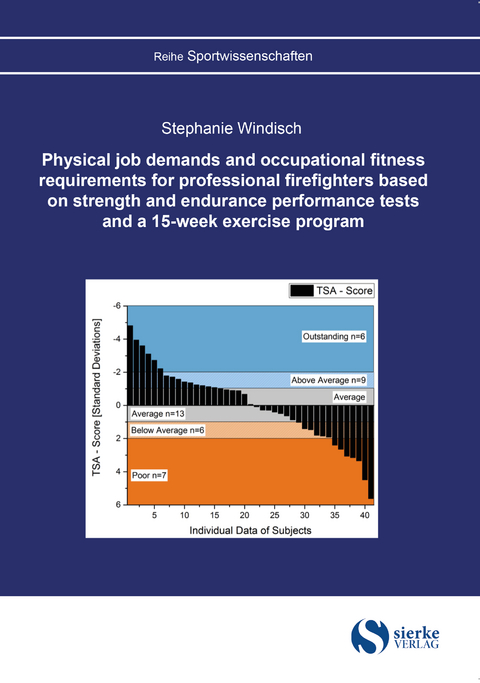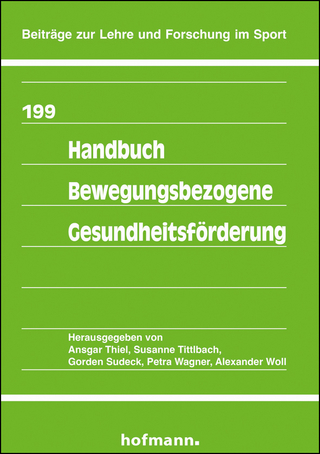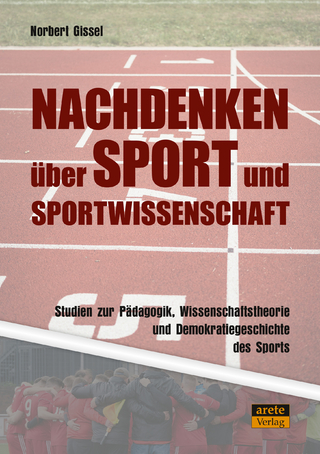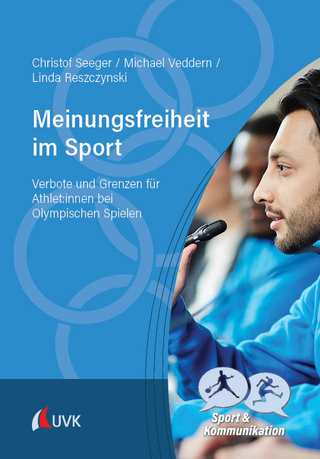
Physical job demands and occupational fitness requirements for professional firefighters based on strength and endurance performance tests and a 15-week exercise program
Seiten
2020
|
1. Auflage
sierke VERLAG - Sierke WWS GmbH
978-3-86844-968-6 (ISBN)
sierke VERLAG - Sierke WWS GmbH
978-3-86844-968-6 (ISBN)
Background and Aim: Firefighters are a unique occupational group, given that they perform strenuous work in unpredictable emergency situations. Their physically-demanding work requires high levels of fitness. The primary aim of this doctoral thesis is to determine the physical demands of firefighting and establish the relationship with important fitness variables. The secondary im of the thesis is to find an exercise program that improves important fitness variables within a given exercise time on-duty. The research outcome should be a best practice recommendation for effective exercises to meet the physical job demands equired by professional firefighting. In Study I, the aim is to quantify the physical demands of a simulated firefighting exercise and identify the relationship between firefighting performance and important endurance and strength parameters. The aim of
Study II is to examine physiological responses to two different simulated firefighting exercises: one in extreme temperatures (300°) in a burning container and a standard firefighting exercise in temperate conditions (20-30°). Moreover, a second aim of Study II is to examine changes in the contribution of strength and endurance capacities to firefighting performance when the demands of the firefighting exercise change. The aim of Study III is to evaluate the effects of a 15-week endurance program for professional firefighters while exercising one hour on-duty by comparing the effects of a high-intensity interval training (HIIT) based on a polarized concept vs. more traditional continuous training.
Participants and methods: In Study I, 41 professional male firefighters performed a maximum treadmill test, a battery of strength and endurance tests and a simulated firefighting exercise twice on four different days. Firefighting performance during the simulated exercise was evaluated by a simple time-strain-air depletion model (TSA) taking the sum of z-transformed parameters of time to finish the exercise, strain in terms of mean heart rate and air depletion from the breathing apparatus. Multiple regression analysis based on the TSA model served to identify the most relevant physiological determinants for professional firefighting. In Study II, sixteen professional male firefighters performed a maximum treadmill test, strength testing, a standard simulated firefighting exercise without heat and flashovers and a firefighting exercise with a simulation of the flashover phenomenon in a burning container on four separate days. Firefighting performance was again evaluated by the TSA model and correlations were subsequently established between TSA- based firefighting performance parameters and fitness variables
representing strength and endurance. In Study III, the impact of a high-intensity interval training (HIIT) within a polarized training concept was compared to continuous endurance training (CT) within one hour exercising on-duty. Thirty professional firefighters were randomly assigned to two experimental (HIIT n=10;CT n=10) and one control (CON n=10) group. Key endurance parameters were assessed during a maximum treadmill test before (baseline-test) and after (posttest) a 15-week intervention.
Results: In Study I, three main factors with a strong influence on firefighting performance were identified (70.1% of total explained variance): relative maximum oxygen uptake (VO2peak), the time during which the firefighter exercised below
their individual ventilatory threshold 1 (VT1) and mean breathing frequency. In Study II, the physiological responses to firefighting in extreme temperatures were found to be significantly higher compared to the standard simulated firefighting
exercise. A high level of relative VO2peak was clearly determined as the most important variable to complete firefighting exercises in both temperate and extreme environments. In Study III, the HIIT training within a polarized training concept improved key endurance parameters such as VO2peak, VT1, respiratory compensation point (RCP) and time to exhaustion during treadmill running (TT) significantly more than continuous training within one hour exercising on-duty.
Conclusion: Endurance in terms of VO2peak was established as an important prerequisite for firefighting in temperate and extreme conditions. However, for standard simulated firefighting exercises it is important to work below VT1. For firefighting
exercises in extreme temperatures with smoke, poor visibility and unexpected flashovers, a high fitness level is required to keep the time spent above RCP as short as possible. Based on the results of this thesis, we recommend that professional
firefighter incumbents take part in annual fitness screening to monitor important key endurance variables. Furthermore, we highly recommend that firefighters include HIIT and a polarized training concept in their endurance training because significant improvements can be achieved within one hour exercising on- duty.
Study II is to examine physiological responses to two different simulated firefighting exercises: one in extreme temperatures (300°) in a burning container and a standard firefighting exercise in temperate conditions (20-30°). Moreover, a second aim of Study II is to examine changes in the contribution of strength and endurance capacities to firefighting performance when the demands of the firefighting exercise change. The aim of Study III is to evaluate the effects of a 15-week endurance program for professional firefighters while exercising one hour on-duty by comparing the effects of a high-intensity interval training (HIIT) based on a polarized concept vs. more traditional continuous training.
Participants and methods: In Study I, 41 professional male firefighters performed a maximum treadmill test, a battery of strength and endurance tests and a simulated firefighting exercise twice on four different days. Firefighting performance during the simulated exercise was evaluated by a simple time-strain-air depletion model (TSA) taking the sum of z-transformed parameters of time to finish the exercise, strain in terms of mean heart rate and air depletion from the breathing apparatus. Multiple regression analysis based on the TSA model served to identify the most relevant physiological determinants for professional firefighting. In Study II, sixteen professional male firefighters performed a maximum treadmill test, strength testing, a standard simulated firefighting exercise without heat and flashovers and a firefighting exercise with a simulation of the flashover phenomenon in a burning container on four separate days. Firefighting performance was again evaluated by the TSA model and correlations were subsequently established between TSA- based firefighting performance parameters and fitness variables
representing strength and endurance. In Study III, the impact of a high-intensity interval training (HIIT) within a polarized training concept was compared to continuous endurance training (CT) within one hour exercising on-duty. Thirty professional firefighters were randomly assigned to two experimental (HIIT n=10;CT n=10) and one control (CON n=10) group. Key endurance parameters were assessed during a maximum treadmill test before (baseline-test) and after (posttest) a 15-week intervention.
Results: In Study I, three main factors with a strong influence on firefighting performance were identified (70.1% of total explained variance): relative maximum oxygen uptake (VO2peak), the time during which the firefighter exercised below
their individual ventilatory threshold 1 (VT1) and mean breathing frequency. In Study II, the physiological responses to firefighting in extreme temperatures were found to be significantly higher compared to the standard simulated firefighting
exercise. A high level of relative VO2peak was clearly determined as the most important variable to complete firefighting exercises in both temperate and extreme environments. In Study III, the HIIT training within a polarized training concept improved key endurance parameters such as VO2peak, VT1, respiratory compensation point (RCP) and time to exhaustion during treadmill running (TT) significantly more than continuous training within one hour exercising on-duty.
Conclusion: Endurance in terms of VO2peak was established as an important prerequisite for firefighting in temperate and extreme conditions. However, for standard simulated firefighting exercises it is important to work below VT1. For firefighting
exercises in extreme temperatures with smoke, poor visibility and unexpected flashovers, a high fitness level is required to keep the time spent above RCP as short as possible. Based on the results of this thesis, we recommend that professional
firefighter incumbents take part in annual fitness screening to monitor important key endurance variables. Furthermore, we highly recommend that firefighters include HIIT and a polarized training concept in their endurance training because significant improvements can be achieved within one hour exercising on- duty.
| Erscheinungsdatum | 09.03.2021 |
|---|---|
| Verlagsort | Göttingen |
| Sprache | englisch |
| Maße | 1480 x 2100 mm |
| Themenwelt | Sozialwissenschaften |
| Weitere Fachgebiete ► Sportwissenschaft | |
| Schlagworte | Berufsfeuerwehr • Berufssprzifisches Anforderungsprofil • Biomechanik • Gesundheitsdiagnostik • Leistungspysiologie • Trainingswissenschaft |
| ISBN-10 | 3-86844-968-X / 386844968X |
| ISBN-13 | 978-3-86844-968-6 / 9783868449686 |
| Zustand | Neuware |
| Haben Sie eine Frage zum Produkt? |
Mehr entdecken
aus dem Bereich
aus dem Bereich
Buch | Softcover (2023)
Hofmann-Verlag GmbH & Co. KG
CHF 69,85
Studien zur Pädagogik, Wissenschaftstheorie und Demokratiegeschichte …
Buch (2024)
Arete Verlag
CHF 33,55
Verbote und Grenzen für Athlet:innen bei Olympischen Spielen
Buch | Softcover (2023)
UVK (Verlag)
CHF 37,75


